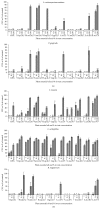Essential Oils from Ugandan Aromatic Medicinal Plants: Chemical Composition and Growth Inhibitory Effects on Oral Pathogens
- PMID: 26170872
- PMCID: PMC4478384
- DOI: 10.1155/2015/230832
Essential Oils from Ugandan Aromatic Medicinal Plants: Chemical Composition and Growth Inhibitory Effects on Oral Pathogens
Abstract
The study assessed the growth inhibitory effects of essential oils extracted from ten Ugandan medicinal plants (Bidens pilosa, Helichrysum odoratissimum, Vernonia amygdalina, Hoslundia opposita, Ocimum gratissimum, Cymbopogon citratus, Cymbopogon nardus, Teclea nobilis, Zanthoxylum chalybeum, and Lantana trifolia) used traditionally in the management of oral diseases against oral pathogens. Chemical compositions of the oils were explored by GC-MS. Inhibitory effects of the oils were assessed on periodontopathic Porphyromonas gingivalis and Aggregatibacter actinomycetemcomitans and cariogenic Streptococcus mutans and Lactobacillus acidophilus using broth dilution methods at concentrations of 1%, 0.1%, and 0.01%. The most sensitive organism was A. actinomycetemcomitans. Its growth was markedly inhibited by six of the oils at all the concentrations tested. Essential oil from C. nardus exhibited the highest activity with complete growth inhibition of A. actinomycetemcomitans and P. gingivalis at all the three concentrations tested, the major constituents in the oil being mainly oxygenated sesquiterpenes. Most of the oils exhibited limited effects on L. acidophilus. We conclude that essential oils from the studied plants show marked growth inhibitory effects on periodontopathic A. actinomycetemcomitans and P. gingivalis, moderate effects on cariogenic S. mutans, and the least effect on L. acidophilus. The present study constitutes a basis for further investigations and development of certain oils into alternative antiplaque agents.
Figures

Similar articles
-
Essential Oils from Ugandan Medicinal Plants: In Vitro Cytotoxicity and Effects on IL-1β-Induced Proinflammatory Mediators by Human Gingival Fibroblasts.Evid Based Complement Alternat Med. 2016;2016:5357689. doi: 10.1155/2016/5357689. Epub 2016 Oct 11. Evid Based Complement Alternat Med. 2016. PMID: 27807462 Free PMC article.
-
Antibacterial activities of extracts from Ugandan medicinal plants used for oral care.J Ethnopharmacol. 2014 Aug 8;155(1):852-5. doi: 10.1016/j.jep.2014.06.027. Epub 2014 Jun 16. J Ethnopharmacol. 2014. PMID: 24945400
-
A comparison of the antibacterial efficacies of essential oils against oral pathogens.Oral Microbiol Immunol. 2004 Feb;19(1):61-4. doi: 10.1046/j.0902-0055.2003.00111.x. Oral Microbiol Immunol. 2004. PMID: 14678476
-
Food preservative potential of essential oils and fractions from Cymbopogon citratus, Ocimum gratissimum and Thymus vulgaris against mycotoxigenic fungi.Int J Food Microbiol. 2009 May 31;131(2-3):151-6. doi: 10.1016/j.ijfoodmicro.2009.02.009. Epub 2009 Mar 4. Int J Food Microbiol. 2009. PMID: 19268382
-
In vivo antimalarial activity of essential oils from Cymbopogon citratus and Ocimum gratissimum on mice infected with Plasmodium berghei.Planta Med. 2005 Jan;71(1):20-3. doi: 10.1055/s-2005-837745. Planta Med. 2005. PMID: 15678368
Cited by
-
Assessment of cytotoxic and antimicrobial activities of two components of Cymbopogon citratus essential oil.J Clin Exp Dent. 2020 Aug 1;12(8):e749-e754. doi: 10.4317/jced.56863. eCollection 2020 Aug. J Clin Exp Dent. 2020. PMID: 32913572 Free PMC article.
-
Investigations of a Possible Chemical Effect of Salvadora persica Chewing Sticks.Evid Based Complement Alternat Med. 2017;2017:2576548. doi: 10.1155/2017/2576548. Epub 2017 Apr 18. Evid Based Complement Alternat Med. 2017. PMID: 28484501 Free PMC article.
-
Utilization of Pomelo (Citrus maxima) Peel Waste into Bioactive Essential Oils: Chemical Composition and Insecticidal Properties.Insects. 2022 May 20;13(5):480. doi: 10.3390/insects13050480. Insects. 2022. PMID: 35621814 Free PMC article.
-
A scoping review on the use of traditional medicine and oral health in Africa.PLoS One. 2024 May 28;19(5):e0297570. doi: 10.1371/journal.pone.0297570. eCollection 2024. PLoS One. 2024. PMID: 38805486 Free PMC article.
-
Cymbopogon citratus Essential Oil Increases the Effect of Digluconate Chlorhexidine on Microcosm Biofilms.Pathogens. 2022 Sep 20;11(10):1067. doi: 10.3390/pathogens11101067. Pathogens. 2022. PMID: 36297124 Free PMC article.
References
LinkOut - more resources
Full Text Sources
Other Literature Sources
Molecular Biology Databases
Miscellaneous

